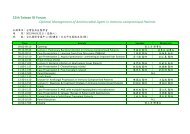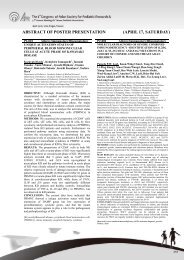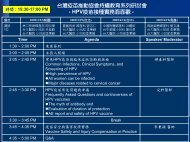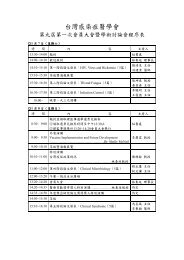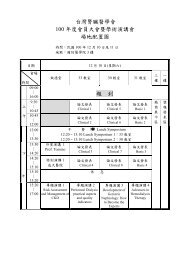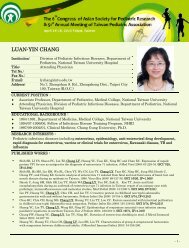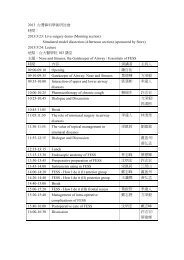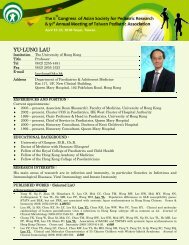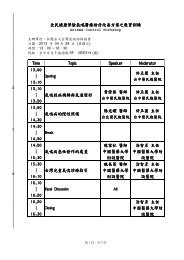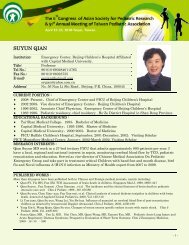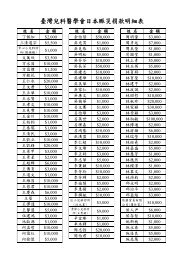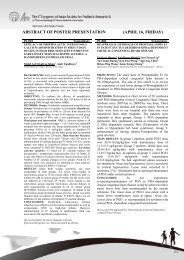ABSTRACT OF INVITED LECTURES AND ORAL PRESENTATION
ABSTRACT OF INVITED LECTURES AND ORAL PRESENTATION
ABSTRACT OF INVITED LECTURES AND ORAL PRESENTATION
- No tags were found...
Create successful ePaper yourself
Turn your PDF publications into a flip-book with our unique Google optimized e-Paper software.
FP8-04IMPLICATIONS <strong>OF</strong> RESTRICTIVE RIGHTVENTRICULAR PHYSIOLOGY IN RIGHTVENTRICULAR ADAPTATION TO CHRONICPULMONARY REGURGITATION IN PATIENTSWITH REPAIRED TETRALOGY <strong>OF</strong> FALLOTChun-An Chen1,2, Jou-Kou Wang1, Wen-Yih Tseng3,4,Chung-I Chang5, Ing-Sh Chiu5, Yih-Sharng Chen5,Chun-Wei Lu1,6, Ming-Tai Lin1, Hsin-Hui Chiu1, Mei-HwanWu1Department of Pediatrics, National Taiwan University Hospital, Taipei,Taiwan, 2Heart Failure Center, National Taiwan University Hospital,Taipei, Taiwan, 3Center for Optoelectronic Biomedicine, College ofMedicine, National Taiwan University, Taipei, Taiwan, 4Department ofMedical Imaging, National Taiwan University Hospital, Taipei, Taiwan,5Department of Surgery, National Taiwan University Hospital, Taipei,Taiwan, and 6Adult Congenital Heart Center, National Taiwan UniversityHospital, Taipei, TaiwanOBJECTIVE: To explore the relationship of restrictive rightventricular (RV) physiology (antegrade pulmonary arterialflow in late diastole) with RV adaptation to pulmonaryregurgitation (PR) in repaired tetralogy of Fallot (rT<strong>OF</strong>).METHODS: We studied 80 consecutive rT<strong>OF</strong> patients (age22.7 ± 7.8 years) without significant residual pulmonarystenosis using cardiovascular magnetic resonance and tissueDoppler imaging. Restrictive RV physiology was assessed byDoppler echocardiography. Surgical methods used for rightventricular outflow tract (RVOT) reconstruction and otherrelevant clinical data were extracted from medical records.RESULTS: Restrictive RV physiology was observed in 40%of study patients. Patients with restrictive RV physiology hadsignificantly lower PR fraction, RV end-diastolic volumeindex (RVEDVi), myocardial performance index, higher latediastolic annular velocity, less RVOT aneurysm andtransannular patch (TAP) than those without. Age at repair(odds ratio: 0.61, P = 0.042), the use of TAP (odds ratio: 0.20,P = 0.031), RVEDVi (odds ratio: 0.93, P = 0.001), andmyocardial performance index (odds ratio: 0.001, P = 0.027)were independently associated with restrictive RV physiologyon multivariate analysis. Furthermore, PR fraction correlatednegatively with RV ejection fraction in patients withoutrestrictive RV physiology, whereas such relationship wasabsent in those with restrictive RV physiology, either inoverall patients or those with significant PR (PR fraction >20%, 55 patients). Subgroup analysis in patients withsignificant PR showed smaller RVEDVi (111.7 ± 14.8 versus139.2 ± 34.2 ml/m2, P < 0.001) and better RV ejectionfraction (51.2 ± 5.5 versus 46.8 ± 9.2 %, P = 0.042) in patientswith restrictive RV physiology (13 patients) than thosewithout in the presence of similar PR fraction between thesetwo groups.CONCLUSION: Restrictive RV physiology was prevalent inrT<strong>OF</strong> whose predominant hemodynamic residual wasPR-induced RV volume overload. It was associated withyounger age at repair, better RV function, less RVOTaneurysm, and less use of TAP during RVOT reconstruction.Uncoupling of PR to RV function in patients with restrictiveRV physiology suggested that this phenomenon might serve asa marker for better RV adaption to chronic PR.FP8-05CARDIAC RELATED TBX1 <strong>AND</strong> TBX20 GENEEXPRESSION ARE DOWN-REGULATEDDURING EMBRYONIC CARDIACDEVELOPMENT IN RETINALDEHYDROGENASE TYPE 2 GENEKNOCK-DOWN ZEBRAFISHJia Hou 1 , Hao Yong Gui 2Cardiovascular center, Children's Hospital of Fudan University 1 , CardiovascularCenter, Children's Hospital of Fudan University, Shanghai 2 (China)OBJECTIVES: To establish a model of retinal dehydrogenase type 2(raldh2) gene knock-down zebrafish embryos, and to explore the effect ofinsufficient retinoid acid (RA) signaling on the early embryonic cardiacdevelopment, especially on the regulation of cardiac relatedtranscriptional factors tbx1 and tbx20 expression..METHODS: We designed morpholino antisenseoligonucleotides (MO) targeting zebrafish raldh2 gene toknock-down its expression and constructed raldh2-EGFPplasmid to verify the effectiveness and specificity ofraldh2-MO. The embryonic cardiac phenotype and cardiacfunction were analyzed and compared between wild-type andraldh2-MO group. Then, we described the expression patternof tbx1 and tbx20 gene in zebrafish embryos, and the regulationof their expression when raldh2 gene was knocked down toelucidate the underlying mechanism of RA signaling in thecardiac development.RESULTS: Raldh2-MO microinjection could effectivelyknock-down raldh2 gene expression, the mortality andabnormal embryo rate rose with the increase of raldh2-MOdosage. Raldh2-MO embryos exhibit abnormal cardiacphenotype, including swollen pericardial cavity, tubular heart,incomplete D-loop, abnormal atria and ventricle development,blood regurgitation, slow blood flow and weak heart beat. Theresults of whole-mount in situ hybridization of tbx1 and tbx20probes revealed that these genes had distinct expressionpatterns, tbx1 expressed in cardiac outflow tract, otic vesicleand pharyngeal arch, while tbx20 expressed in cardiac outflowtract and atrium, branchio motor neuron, tegmentum and retinabut both of them expressed in the embryonic heart. In raldh2knock-down embryos, tbx1 and tbx20 expression weredown-regulated in the heart to some extent.CONCLUSIONS: The RA deficiency zebrafish embryo modelcan be effectively established by raldh2-MO microinjection.RA signaling plays a critical role in several key stages ofcardiac development and may interact with cardiac relatedtranscriptional factors to regulate cardiogenesis anddevelopment. The expression of tbx1 and tbx20, which playimportant roles during embryogenesis, can be regulated by RAsignaling during cardiac development, and the underlyingmechanism still needs further investigation.[Keywords]retinal dehydrogenase type 2, retinoid acid, cardiacdevelopment, tbx1, tbx20, zebrafish[Keywords]Tetralogy of Fallot; Restrictive right ventricular physiology;Pulmonary regurgitation; Tissue Doppler imaging; Cardiac magneticresonance86



